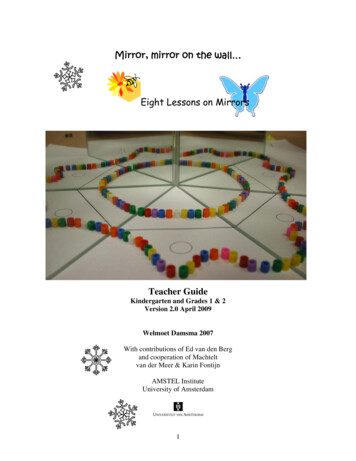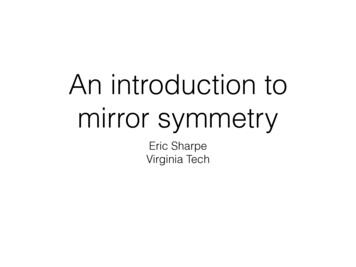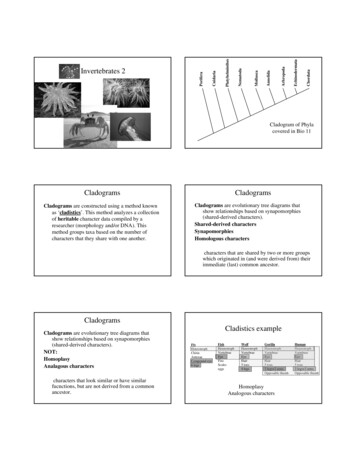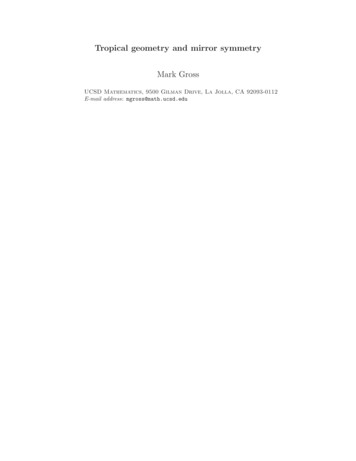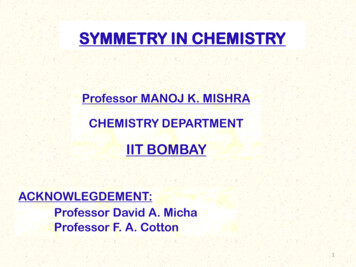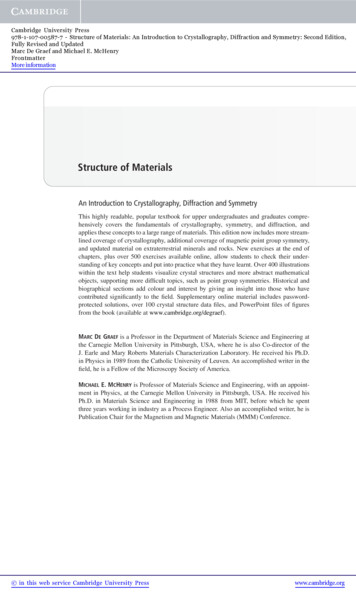![The Symmetry And Crvsta] Structure Manganite, M (OH)O.](/img/62/zk95-163.jpg)
Transcription
lG3The Symmetry and Crvsta] StructureManganite, M (OH)O.By M. J. Buerger,"Vlinera logica] Laboratory. 1Iassachusctts InstituteCambridge, 1Iassachusetts(USA.).ofof Technology,A bstrac1.A rough structurefor manganitehas already been proposed by Garrido.Although unrecogni7.cd, this is a marcasite-likcstructure.From its formula, manganite ought rather to have an arsenopyrite-likestructure, which is a superstructurebased upon the marcasite type. A new structural investigationshows that this isthe case.YIanganite is definitely monoeIinic, not orthorhombic" as stated in all referencehooks. This lowered symmetry is cvidenced by the po]ysyuthetictwinning on thesupposed symmetry plane, (100), by inclined extinction in systems of twiu bandsin eleavage flakes, and by the diffraction symmetry. 21m.The new structural investigation has heen made by the equi-irwlination VVeissen berg method and inspeetive interpretationof films. The rnanganite structurehas the tion):,Space group:UnitEquipoints:H2r/daH.HU Acell :bm general;.raYi!all atomsParameters:j}InD.24r - : .70fJ 0 90 1O2. o.119.119position.Z, o.258.122.1220.500The formula .Mn(OH)O corrcsponds geometricallypyrite formula PeAsS; the 01 atoms are almostand physically with the arscnoecrtainly (011) groups having afunction similar to As and Sb in arsenopyrite and gudnnmdite. The (OH) grouphas a radius ahout .07 A greater than the 0 atom.The structure, although resembling the arsenopyritestructure.is. in greaterdetail, a layer structure:1I1n is in square eoordinationbetwccn 2(OH) and 20 inthe samc (010) sheet with one more (OH) and onc more 0 above and below the centerof the square and in adjacent sheets in such a way as to approach octahedm] coordination for the Yln. The hydrogen bonding and the mild layering of the structure into (010) sheets account perfectly for the outstanding(010) ekavage and the(010) translation-glidingplane.Introduction.A erystal structure of manganite has recently been proposed hy C arrid(1).Although recognizing that certain faint refleetions required doubling of his cellaxes in two directions, Carridoderived a rough structure with the following characteristics:u.1) Garrido.(1935) 224-241.Zeitschr.4.42 Ab 5.23 A1\-1.,r., Structuref. Kristallographic'.I);). Ed.de In manganite,c 2.87 A.Bull. Soc. Fran.". Mineral. 5811
1642\1. .J. BuergerFormulaSpaceweightsgroup:per cellvJ,2.1}!n at ()OO;oat u/)O;whcre ur 2JJnO(OH) } .17,'uO;}-! v.II.25.:{3R1.12'"2'it, 1\-J.Although Garridoapparcntly did not recognize the fad, this is a marcasitetype structure, a correlation which becomes apparent if manganiteis referred tothe marcasitc orientation.This is done by means of the following eydieal permutation ofax('s :rnanganitenlarcasitea-- Iib.- cc-- aGa rrido' s manganite and the marcasikthe marcasite orientation:mineralstlH'n comparernanganitpabFormula weightsper :{74.445.3U2.R74.42,).2:{2FeSS21IIn(OH)OPrnnnSpace group:Mctal position:1\on-metal position:as follows. usmg 2FcAsAsV)/000, ,\,\}Ouv;parameters:nr(hID; , -/1t,}r;},.21).203.33R.375u.- '/"-.175.361From this point on, the standard manganite orientation wil! be cmployed indiscussing 111anga.nite.1\ow, the formula type of manganite, 1J,ln(OH)O, is not the A B2 type requiredfor thc eustomary marcasite structure.It eorresponds, rather, with the arsenopyritetype of formula, A B' Bn, and therefore manganite should be investigated for arsenopyrite-like characteristics.Thesc have been listed in the arsenopyritepaperl), towhich tabulationthe following refcrenees apply.Garridohas already prcsented a ccrtain amount of evidenee tending to corroborate a eonjeeture that manganite has the arsenopyritetype crystal structure.Thus, hc found faint reflections indicating that the true eell should have doublethe a and e axcs of the onc he chose for thc rough structure.This eonfirrns eharacteristie 4. (Sec tabulation in the arsenopyritepaper.) A preliminary investigationby the writer developed the fact that the 0.0.4 series of speetra eonstitutes a graduallydeclining2) intensity serics rathcr than a regu lar ly dcclining series whichcharacterizesthe pure marcasite type of structure.i\langanite therefore has certain arsenopyrite-likecharacteristics.-----1) Buerger,the arsenopyrite2) Buerger,2\1. .J., The symmetry and crystal strueture of the mineralsgroup. Z. Kristallogr.(A) 95 (1936) 112-113.:VI. .J., op. cit.,91-92.of
The SymmetryNotesand CrystalStructureon the Symmetryof }langanite,Mn(OH)O.16;')of 3'Ianganite.The writer had access to a number of manganite specimens from Ilfeld, Germany, which is also the locality of Garrido'smaterial. A numberof analyses of manganitefrom this locality have been eolleeted byKoeehlin1).In the best of this material, from which small crystals were selectedfor X-ray investigation,it is quite apparent that there arc twin lamellaeparallel to (100) which show up plainly on the crystal terminations.Sinc:e(:100)would be a symmetry plane if manganite were orthorhombic,andsince twinning cannot oc:c:ur on a symmetry plane, it is elear that manganite cannot be orthorhombic:.as recorded in all reference books. Thesymmetry of rnanganite has been under suspicion before, but the anomalies have always been explained away. The subject is reviewed hyKoechlin2)and by Hintze3).Importantevidence. for a symmetrylower than orthorhombicisthe inclined extinctionof alternatesystemsof bands 4)5) seen bytransmitted polarized light in thin cleavage flakes. These bands arcevidently the cross-sectionsof the ('100) twin lamellae mentionedabove.To these evidences of lower symmetry, the writer adds the following:If a rnanganite cleavage splinter (bounded by the excellent (010) andperfect (110) eleavages) is set up on a two-cirele goniometerwith thecleavage zone taken as the equator,then the natural(001) surfacemay have a (! coordinateof almost 4 . This should be 0 if thecrystal is orthorhombic.and it is this deviationwhich permits thepolysynthetic twinningto be observed on the basal terminationofthe cry"tal.This face, however, is a vicinal one and not the structural pinacoid,for crystal settingsmade with its use give poorlyoriented X-ray photographs.1) Kocchlin,l{., in Doeltcr,C. and Leitmcier,R., Handbuch del' '\Tineralchemie, l1I2, HJ2G, pp. k47-k48,analyses 4, 5, (), 10, 13. 14. 1;';, 16, 17.2) Koechlin,R., op. cit., p. 847.3) Rinbe,Carl,especial1y footnote 1.Handbuchcler Mineralogic,vol. 1, part 2, 1\H5, p.lH78,4) !VIiigge, 0., Zur Kenntnis del' optischcll und KohiisionseigenschaftendesManganit. Zbl. }lineral., Geol., Palaont. 11122, 1-2.5) Gnl'l'ido,:\1. .J., Structure de la mangnnite, Bull. Noc. Fi'Hn ;. }lil1( ral. 58(1935) 225.11*
}J. .J. BuergerlUethod.The X-ray study has be('n carried on entirely by the equi-inclinationW cis.sen berg method ')2)") and a1l films have been interpreted by the inspeetivc methodwithout indexing procedure. The cell characteristicswere derived froll1 films madewith Pe K rildiation. The pamnwters were fjxed from reflection jntensities recordedon two complete sets of equatorial films, one set under-exposcd to differentiate thejntensiti('s of the stl'Ong ref]('etions and the other set oVf'r-exposed to a1low comparisons between weak rcfJeetions.(;ell eharacteristics.Diffraetionsyml!1etry.The equi-inclinationWeissenbergphotographs for rotations about each of the three customary manganite axesaJl display a position symmetrywhich cannot be distinguishedfrom-02/. The intensity distributions,however, are partly of ]owe1' symmetry:Rotations about the b axis give equi-inelinationWe is sen be r g filmsdisplayingthe symmetryO2 for aJl levels. Rotationsabout the customary manganit(, a amI c axes both display the symmetry C21 for the 1:erolevels and O{ for the II-levels. (See Figs. 1--5).:Fig. 1 3.Pl'Oof of the inferior symmetryof manganite ami of the l3-eenterednature of the nHtnganite lattic(' referred to the customary manganite axial orientation. ote that all photographs display the position symm('try 2/, with the symmetry lines in the positions indicated by both full and broken inked Jines. Theintensity distributions,however, display a lower symmetryin some eases: onlythe full lines are true syn))netr c lines when aceonnt is taken of the intensity distribution. The photograpllsindicate the following information:rOf1't', ;;pO!]dingorthorholtlld('p!aJlp lattif'('pattpl'lIFig.Fig.Fig.Fig.Fig.1:2:3:4:G:a axisa axisr; axisc axisb axisequator1st layerequator1st layerequatorThis information constitutesmanganite axial orientationthe 2-fold axis.11101110Rcorresl)OndingorUlorhombil' ta('hillgSC(jUf'Df'C10107proof that the cell is B-('elltered with the customaryand that manganite is monoclinic with the b axis asi) Buerger,;Vr. J., The \Veissenbergreeiprocallatticeprojection and theteehnique of interpreting\V e i ssell berg photographs:Z. Kristallogr. (A) 88 (1934)3iW-:3RO.2) Buerger,,\1. J., The application of plane groups to the interpretation ofWe issen berg photographs:Z. Kristallogr.(A) HI (19:35) 23fi-28!J.3) Buerger,M. J., An apparatusfor eonvenientlytaking equi-inelinationWeiss en berg photographs:Z. Kristallogl'. (A) !H (ilJ3G) R7-!JH.
The Symmdryand CrystalStruetureof '\IanW'onik,Mn(OH)O.,/.!!,I I'"1;1ig. L-;IFig. 2.;-/.//.1-/Fig. 3.Fig. 4.1 ()?
JI. .J. BuergerThe diffraction symmetry is thusplainly '2/rn, and the crystal system,./is plainly monoclinic,in harmony/I/with the symmetryobservations alIready made. The customary manganiI/ite b axis is the two fold axis; no/Ichange in the customarymanganite/Iorientationneed therefore be made/I//from a point of view of symmetry.,/The patSpace lattice type./terns of the equi-inc1inationphoto//graphs of the various levels for the b/axis rotation are all identical, indi/Icating that the primitive and not theIcenteredlIlonoe1inic lattice is theIIbasic group of translationsfor man/ganite.Theaandcaxesof thisIprimitivetranslationunit extend in//the [1OJ] and [1Oil directions referredto an appropriatece]] with edgesparallel to the customary manganiteaxes. The customarymanganiteaxes may he retained,however, bychoosing a doubly primitive, B-centered cell. This alternativechoice isdesirable for it brings out the pseudo-orthorhombiccharacterof thecrystal and also avoids the confusion of a new orientation.The B-centering of the manganite ce]] lIlay now be justified in somedetail, because this is contrary to Garrido'sindexing. A rigorous studyof the B-centcring was made by comparison of the several equi-inclinationphotographsfor the same axial rotation.All levels for rotation abouttIle b axis display the plane lattice typel) 8 (referring in this discussionto the eorrespondingorthorhombiclevel patterns because of the strongpseudo-orthorhombicdimensional aspect). For rotations about the a andc axes, the level patterns are type 1J for even levels and type 10 forodd level", (Figs. 1--5) i. e., the plane net "tacks arc both of type iO. Thelattiee is therefore B-eenteredwith the axes chosen.Ce]] dimensions.A study of the rotations about the three eonven-I///,// --tional manganite axes, together with a studyphotogra ph s indicates the following cell:of severa]W ei ssen berg1) Buerger,M. .1., The application of plane groups to the interpretationW pisspn hpJ'g photographs:Z. Kristallogr.(A) !n (HJ35) 2;';5-2StJ.of
The Symmetryand CrystalStructureof }Ianganite,Garridoabc8.845.236.74A Wn(OH)O.169Buerger8.865.245.70AGarrido'svalues for the larger unit arc also given in comparison.Thetwo sets of values are in good agreement. This cell accomodates 8 formulaweights of Mn(OH)O.Space group.A comparison of equatorial films with the n-Iayerequi-inclination films reveals the characteristicextinctions of space group-B2Ild discussedin detailin the arsenopyritepaper1).'['he Crystal Structure.It should be pointed out that from the cellGeneral argument.dimensions, end-centering,and pinacoid reflectionintensityseries itcan be proven that manganitecannot be referred to an orthorhombicspace group, even without the several symmetry evidences already given.This eliminationof orthorhombicspace groups follows the discussiongiven in the arsenopyritepaper.Since the space group extinctionscan be recognized, it is possibleto seek appropriateparameters in the correct space group B2I1d directly.In the initial stages of this investigation,however, crystals sufficientlyfree from twinning were not utilized to enable the space group to berecognized easily by its extinctions,so that indirect approaches were ofconsiderable assistance, and even now, they add confidence in the correctness of the final structure.An indirect approach to the structuremay be made with the aidof Garrido'srough structure:If no distinctionis made between (OH)and 0, then manganitehas a rough marcasite structure.If account isnow taken of the true cell characteristicsand also of the alternationof(OH) and 0, then it can be shown2) that there are only five possibletypes of alternations,belonging variously to space groups Om, 02, andB2Ild. Only the last space group gives the extinctions actually observedin manganite. To this space group belong two related types of alternations,designated ab' ba' and cd'dc', differing only in the position of the manganese atom. Instead of blindly seeking parametersin space group B2Ild,1) Buerger,:VI. ,J., The symmetry and crystal structure of the minerals ofthe arsenopyritegroup. Z. Kristallogr.(A) II,')(1936) 83.2) Buerger,lVI. ,J., A systematicmethod of investigatingsuperstructures,applied to the arsenopyrite crystal structural type. Z. Kristallogr. (A) 114(193(1) 425.
1701I. .J. Buergerit is desirable to examine the parameters in the regions of the two possiblestructuresab' ba' and cd' dc', whieh considerablyshortens the labor ofselecting the correct structure.Structure ab' ba'.centers and henceof the parameterscan be shown thatbe simultaneouslypointed out in theStructure-In this structure, the jJ;lnatoms occupy symmetryare without degrees of freedom.By trial variationsof the remaining atomstwo varieties of oxygen -itthe hOO, 001 and hOh reflection intensitiescannotsatisfied.This structure is also physically unlikely asarsenopyritepaper.cd' dc'.-This alternativepossibility is undoubtedlythecorrect structure.It gives an excellent explanationof the intensitieswith appropriateparameters.l:nfortunatcly,with the identical scatteringpowers of (OH) and 0 (as compared with the correspondingAs and Sin arsenopyrite)it is difficult to place these units separately.An approximation is possible, however, based upon the parametercom hinationsfound in the other arsenopyrite-likeminerals. I t is found that the nearerthe non-metals arc in radius, the more nearly identical arc correspondingparametersfor the two non-metals.With this approximationthe parameters for the ab projection may be found.In the case of the manganitefrom which the writer's films wereprepared, an attempt was made to secure material free from twinning.While a measure of success was achieved in eliminatingtwinned areas,a truly perfect single crystal was not obtained.TIJis makes the comparison of odd with even orders of 101 somewhat unreliable.The parametersmanganite('1b('1"l1']nfor01 0 4a',O24:3;0'4444'arcX(I('1"U: aH folJows:'0'1HO-A comparison of observed intensitiesparametersis given in table 1. .000YbZc .000.258.11U.122.11U.122.000.;iOOwith those calculatedfor these
TheTableLordersealeubtedH3(j!J and CrystalSymmetryComparisonorders/Iof 1012j}In(OH)O. oealeulatedordersobservedC llculat2!J1H/I 4 .I171reflectionorders of 001observedealculatedIof Mang tnite,of calculatedand observedintensitiesfor manganitc.of 100observedStructureof 010ed observedH3G\). 4168- 4;)424G78472W, 24Hi12432;)-1:3 j4, G, 8gradualdccline,lecline'-- 4v54-IG, 24Hi.I" .)11.:3Hi8I!24 ;)1H12Igradual1200 431225-1/20 -720:3 -11.2-H.7;;10 -H.277 5./1.)11D.n"- 12 -20:14.H 10.v207D, 114.42.412Hiseussiollof the Strncture.The manganitestrueture is shown in figure (5. Certain of its interatomic: distanc:es c:aklllated on the assumptionof orthogonalaxes arcgiven in table I I.TableII.atom1 InInteratomic:eoordinates.cyzdistancesbetweenin manganite.neigh bor0,O2 .Y-;t' --- t,distanceI.-2 'y,y,x,-!I.!I,y,-J'.--.-;r,. y,.LI:r- 2.30-I.\)21 2.30-zIy .- "2, r,x. 2 }InIT'J'O21 [nneighborscoordinates 1 1nearest- -". -z11.85 I 12.7Gz2.94--A
172M. .J. BuergerTable II yzX--xx --1Y '- 2.X.y.Zx.-- y.- ]zccyz1Wny.x.y.x.]y.z-1Z--,1-.- 1X -I--- 1 2atomsoccupypresentsthe centersunits accountof theseadditionalbondingTherein dsof theplanedistancesIt is ratlwrto a coordinationatoms.varioussquareThe greaterapproachsharedI--z-- zz2.]2.85,2.992.47]2.96"Z-features. 2.99To the first approxi-is rutile-like.The hinthesezone.The relativemodifiedby thebeyond.twoAA2.30 A2.30 Aof 1.85two of L92one of. edgesone ofaccuratelydetermined,thatatomsthanto the otherof the lasttwooxygenstructure1.85]'- :.rhowever,of oxygen2.30 distances:can be ratherdistances2.992.65is considerablyof the shareda laYf'r2.472.96Zz -i 1edgescertain,2.96z c 1Y -- ':f.indicatedMn-Oofz].-zin the prismaticcleavages:r"zy,YoctohedraThe strongand the layeringare fourtwoof oxygenfor the several cleavagesperfection]the structureedges.-4'some interestingbe said thatthe c axis by sharingLX-1---Z] 1if.x-I- 2'-.X.-2.85f- 4]Z -j- 4y,yX '4'.O2it mayy.2.] 2The structureX.X, 1 1mation,y.2.65zy.-I1.92::y. .lWn-2' 12.Yx.2.30 z ]2"1-2'Y -'4.- zy.y-4'-L I4'x,y-]lWnZ- J.X -'x]1- 414-'4'x.-distancetypf'.the manganeseatomsthe lastis closertwo oxygenmake the
The Symmetryand CrystalStructureof l\1anganite,173Mn(OH)O.The 0-0distancealong the sharededges is 2.47 A which is thesame as is found in rutile. The 0-0distance between the oxygens belonging to different unshared cation coordinations,however, is subnormal,namely 2.65 A. This evidently indicates a hydrogen bond of some sort.but apparentlynot the hydrogenbond as ordinarilyunderstood.Ifan ordinary hydrogenbond were in this position, with the hydrogenlocated equally between the two neighboringoxygens, then all oxygenmanganesedistanceswould be the same and the crystalwouldoriginFig. 6.The crystal structureof nmnganitc asseen along the c axis (upper diagram)and along the b axis (lower diagram).The locationsof the screw axes areshown.Diamondglide planes (glidecomponentsaf41cf4)occurattandi)6r .(f QJ'\ i.'.-0.i"./0,-'.11bC lutPCYnormal to b bllt are omitted for sake ofclearness.Inversioneenters occur be.tween the oxygen pairs.Small atomsaTe 111anganese, large atolllS oxygen.The latter are of two slightly differentsizes, the larger of which (showing nogaps between pairs) are probably essen.tially hydroxyl groups.oI 1I3I 4 5I 6I 7I 8I 9I mAhave degeneratea and c identity periods, i. e., manganitewould be amareasite-like,not an arsenopyrite-likecrystal. The only way of accountnig for these dou bled marcasite axes in manganiteis either by assumingsomething different about two of the four ivln-O bonds in the plane ofthe shared edges to aecount for the two different .Mn-O distances there.or by assuming that 01 and 2 have different characters, including radii,as in the case of the other arsenopyritegroup crystals.With the latterassumption,manganitegives a good parallel with arsenopyritegroupcrystals if 01 is regarded as (OH) and compared with As in arsenopyrite,while O2 is regarded as oxygen and compared with S in arsenopyrite.Adopting the designation(OH) for ()1 and 0 for 02' it becomes apparentthat the Mn-(OIl)distance and the ivIn-O distance in the plane of
174 \r. ,J. Buerger,The Symmetryand CrysbLl Structureof .\langanite,}Jln(OH)O.the shared edge give the (OH) group a radius greater than the oxygenatom radius by about .07 A.The bonding may now be examined in somewhatgreater detail.The manganese atorm; are more accuratelydescribed as located at thecenters of oxygen-hydroxylsquares which join edges to form tilted ribbonsrunning down the c axis, thus:u.mOThe (OH) groups of one ribbon,themsel ves to the 0 atoms ofthe adjacent ribbons to form a (010)sheet corrugatedin the direction [001].The additional(OIl)-Ohands withinthe (010) sheets make them strongstructuralunits. The outstandingexcellence of the (010) cleavage over theother cleavages in the prismatic zoneis thus produced.Since the sheets arecorrugatedalong [001] and have anappropriatecharge distribution 1) thestructure alBo accOlwts perfectly for the(OIU), t[001],gliding clements T0 -.um(OH}-(OH}.MnbondMnum(OH)-(OH}-.u.O-O'u MnMnuuum(OH)-(OH)-u-m" 0-0MnMn!c.u(OH)-(OH}-.mO-O' discovered by YIiigg(2).The somewhat greater JIlI/-O andJvlu-(OH) distance between these (010)sheets than within them has a ten1dency to make the structurea IllildThis feature enhances the ease of cleavage and gliding.layer structure.1) Buerger,:\1. ,I., Tmnslation.glidingin crystals of the NaC1 structuralAmer. ;Vlineralogist 1:; (1!J: O) 237.2) \Iiigge, 0. hur Kenntnis del' optisehen unel Kohiisionseigellsehaftendes}langanit.Zbl. \rinel'aL, (;eol., Palaont. W22, pp. 1-2.type.}lineralogicalReceivedLaboratory,Cam bridge,MassachusettsMassachusetts,11. Julyl93G.---InstituteIJSA.of Technology,
The Symmetry and Crystal Structure of}langanite, Mn(OH)O. 16;') Notes on the Symmetry of3'Ianganite. Thewriter hadaccess toanumber ofmanganite specimens from Il-


